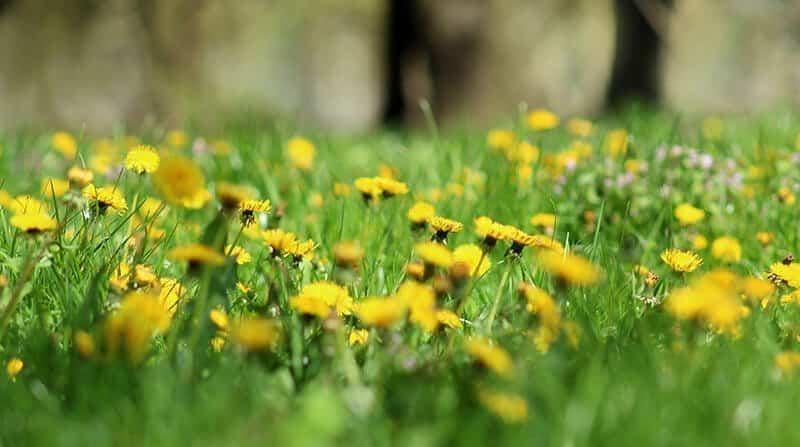Dandelions and Dandelion-type weeds can be pretty disfiguring to your lawn with large rosettes of distinct leaves and their all too familiar yellow flowers.
But did you know there are 5 different weeds that resemble Dandelions?
Chances are you see them and automatically think you’re looking at a Dandelion when in fact, you could be looking at Cats Ear, Smooth Hawks-Beard, Mouse-Ear Hawkweed, or Autumn Hawkbit.
In most cases, you’ll be looking at either Dandelions or Cats Ear as these are the two most common. The others are occasional eyesores with Autumn Hawkbit being the most uncommon.
All that said, the process for killing and ridding your lawn of them is the same.
What You Need to Know About Dandelions and Dandelion Type Weeds
In order to remove Dandelions and Dandelion type weeds from your lawn, it helps to know a little bit about them;
Appearance
The treatment of Dandelions and similar weeds is very much the same but still, it’s useful to know how to tell the difference between each species.
Dandelions

The most common weed which often grows alongside Daises, Dandelions or Taraxacum officinale have a large, flat rosette of leaves which come from a long taproot. Their leaves are a distinctive lance shape and hairless with deep, raggedy teeth which point downwards.
Their bright yellow flower heads, which are visible between March and November bloom from a smooth, fleshy, hollow stalk. The flower heads turn into the famous clock seed heads as the flower matures.
Cats Ear
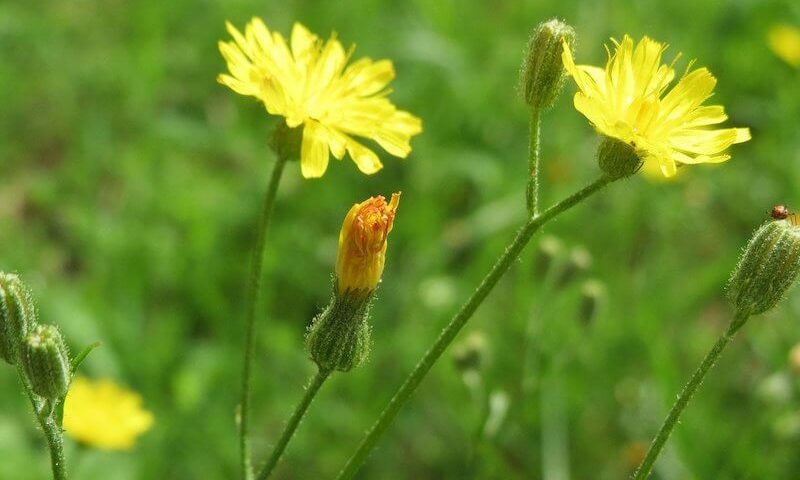
Also common is Cats Ear or Hypochaeris radicata.
It has a large, flat rosette of leaves that grow from a long fleshy taproot. They have a similar lance-shaped leaf but they differ in the fact they’re hairy and although they have toothed leaves, the teeth are much rounder and they don’t point downwards.
Their flowers bloom between May and September and sit on top of a solid stalk that bears small black scale leaves. These stalks often branch into two, producing two flowers. Dandelions don’t.
Smooth Hawks-Beard
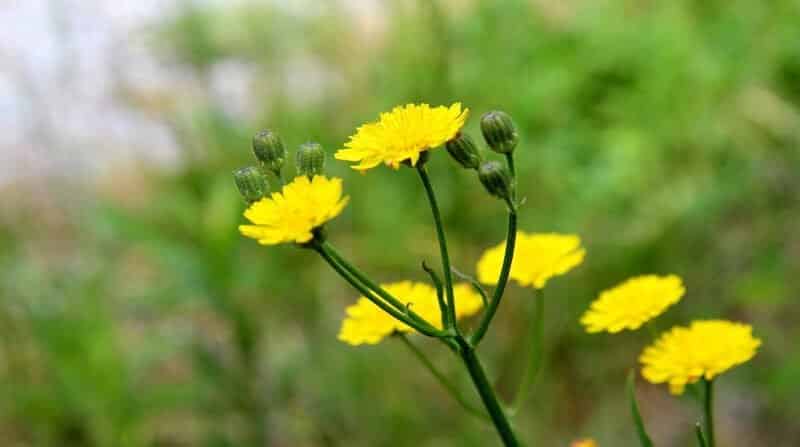
Smooth Hawks Beard or Crepis capillaris isn’t as common as the Dandelion or Cats Ear but it can see still be a nuisance.
It has a flat rosette of leaves which come from a single taproot. The leaves are very similar to Dandelions in that they’re heavily toothed but the teeth are smoother in shape. They’re narrower than Dandelion leaves too.
The solid stalks have several branches, each one topped with a yellow flower which blooms between June and October.
Mouse Ear Hawkweed
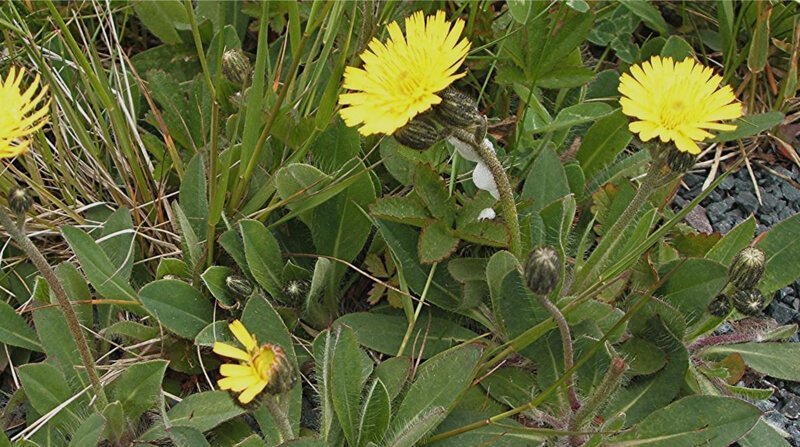
Mouse Ear Hawkweed or Hieracium pilosella is also known as Creeping Hawkweed. It’s pretty uncommon but it can make an appearance.
The leaves differ from Dandelions, Mouse Ear, Smooth Hawksbeard and Autumn Hawkbit. They grow in a stiff rosette but they’re oval in shape and the surface is covered in white hairs.
Creeping stems grow from this rosette, which is how the weed spreads.
Like the Dandelion though, a single yellow flower tops a single, leafless stalk and are visible between May and August.
Autumn Hawkbit
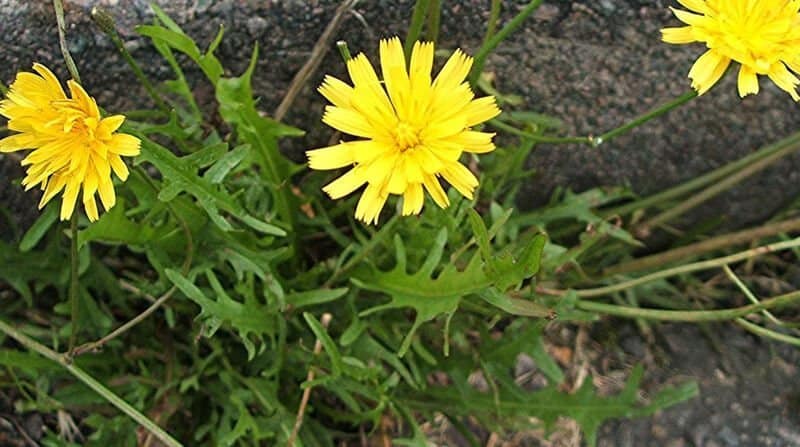
Autumn Hawkbit or Leontodon autumnalis is the most uncommon of all the Dandelion type weeds.
It has a flat rosette of leaves which is smaller than that of Dandelion or Cats Ear and the leaves are narrow and deeply toothed. The surface is shiny and hairless.
Again the flowers are yellow and top branched flower stalks. They’re seen between July and October.
Perennial Weeds
Dandelions, Cats Ear, Smooth Hawks-Beard, Mouse Ear Hawkweed and Autumn Hawkbit are all perennial weeds This means the same one can grow back year after year if not dealt with. They can grow virtually anywhere from cultivated ground, all kinds of soil and even cracks in concrete.
Difficult to Eradicate
It’s difficult to eradicate dandelions completely because they spread quickly via the seeds on their clock heads. A child blowing one of them can release hundreds, if not thousands of new seeds into the air.

Dandelions and Cats Ear also grow large roots known as ‘tap roots’ which can grow up to 3 feet deep into the soil. If you leave even the tiniest bit of this root in the soil when digging them out, Dandelions and Cats Ear can grow back.
How to Remove Dandelions and Dandelion Type Weeds From Your Lawn
As I have already said, completely eradicating these weeds is a tough job. But here are a couple of ways to remove them;
Dig them Out
This has to be the most ineffective way. That said, if you only have one or two weeds and you prefer not to use a weedkiller, try digging them out.
The problem with digging out Dandelions and Cats Ear is that if you leave any fragments of root in the soil, the weed can grow back. This means you’ll potentially have to dig deep and wide to make sure you get the whole root.
There are many specially designed tools which make removing lawn weeds like Dandelions easier and less messy.
Dig plants out as soon as you see them and try not to allow them to flower or seed.
Kill Them With a Selective Spot Spray Weed Killer
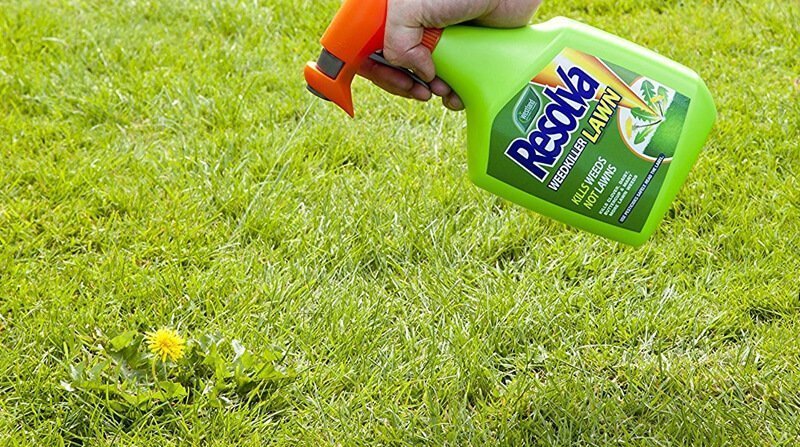
Again, if there are only a few weeds in your lawn and you’re happy to use a weedkiller, spray them individually with a selective, spot spray weed killer like Resolva Weedol Lawn Weed Killer.
This kind of weed killer is perfect because it kills all kinds of broad-leafed weeds as well as other weeds like Lesser Trefoil and clovers but it’s gentle on your lawn.
- Small spray bottle ideal for small areas
- Non-glyphosate formulation
However, if these weeds are taking over…
Treat the Whole Lawn With a Selective Weedkiller Concentrate
If there are loads of Dandelions and other weeds in your lawn, spot treating them is futile. It’s best to treat the whole lawn with a selective weedkiller concentrate like Scotts Weedol Lawn Weedkiller Concentrate.
- Apply through a sprayer or watering can
- Non-glyphosate formulation
It is designed to be mixed with water and applied with a watering can or knapsack sprayer. You do have to make sure you dilute it correctly though. Dilute it too much and it won’t be strong enough to kill the weeds, make it too strong and you risk killing the grass.
So make sure you read the instructions!
Read: The Best Weedkillers for Lawns
How to Prevent Dandelions and Other Weeds from Growing in Your Lawn
You’re bound to have at least the odd Dandelion grow in your lawn at some point, no matter how well you care for it. But if there is a lot of them along with other weeds, this is a classic sign of poor lawn health.
Killing the weeds is only half the battle. If you want to prevent them from coming back you need to do everything you can to make sure your lawn is healthy and dense. If your lawn is thick and lush there won’t be any room for weeds to grow.
Here are the steps you need to take to keep your lawn healthy.
Mow the Lawn Regularly
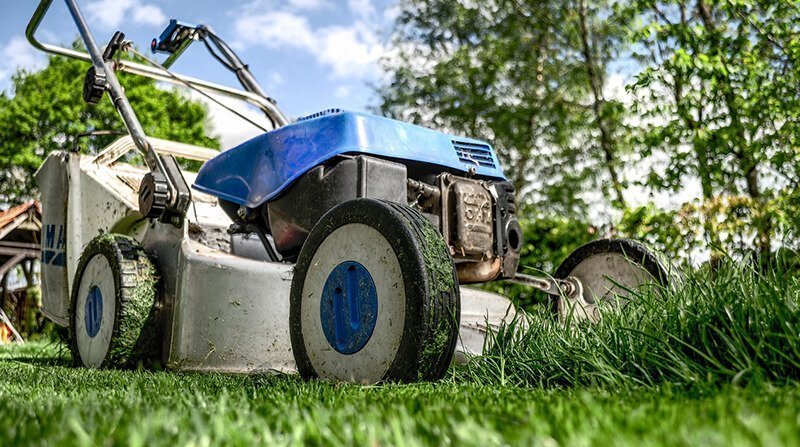
Mowing the lawn regularly is by far the most important part of maintaining a healthy lawn.
Regular grass cutting prevents the grass from growing upwards so it grows sideways, growing new roots and leaves. This result in a thick lawn with lots of grass which means less room for weeds to grow.
Mowing your grass a little taller when conditions for grass growth aren’t perfect will block the light that weeds need to grow.
Read: How to Mow the Lawn Like a Pro: Everything You Should Know About Grass Cutting
Remove Excess Lawn Thatch by Scarifying
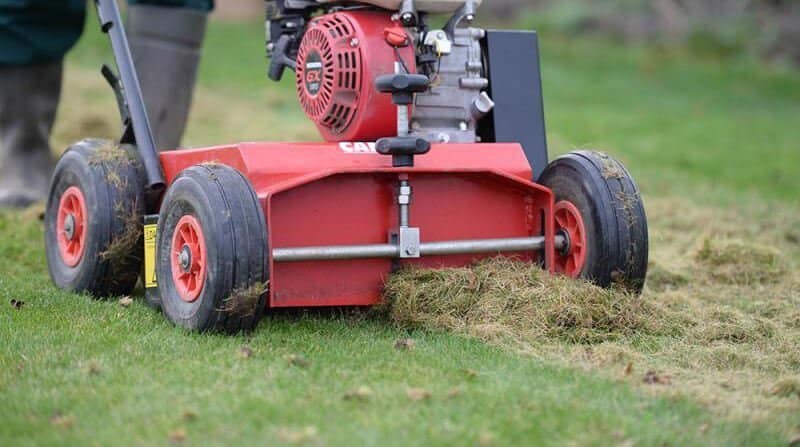
Lawn thatch is made up of living and dead organic matter which sits just underneath the surface of the soil. This organic matter consists of living and dead grass roots as well as other material.
Some lawn thatch is a good thing as it hardens the lawn against disease. But too much will prevent water, air and nutrients from penetrating the soil. Without these, grass can’t grow and when grass can’t grow, weeds and moss are like to take over.
Test your lawn for excessive lawn thatch and scarify if needed (in the Autumn!) to reduce it.
Read: Lawn Scarification: Why, When and How to Scarify Your Lawn (The Ultimate Guide)
Also Read: Lawn Scarifier Reviews, Plus Buyers Guide
Aerate Your Lawn to Reduce Soil Compaction
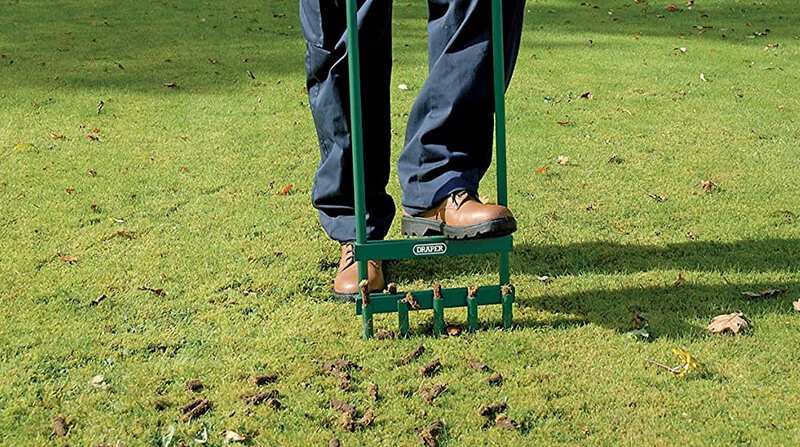
If your kids and pets play on the lawn, then chances are the soil is compacted.
This happens when the forces on top of the lawn (kids playing for example) press the soil particles together under the surface. This, in turn, squeezes out the air and water and prevents them, along with nutrients from being able to penetrate the soil.
Other areas of your lawn that are prone to compaction include; goalpost areas, around the washing line and the route that your postman takes over your lawn to your front door.
Weeds like Dandelions, daisies and moss thrive in compacted soils.
By aerating your lawn you allow it to breathe and take in water and the nutrients it needs to stay healthy.
Read: Lawn Aeration: Everything You Need to Know About Aerating Your Lawn (The Ultimate Guide)
Fertilise Your Lawn
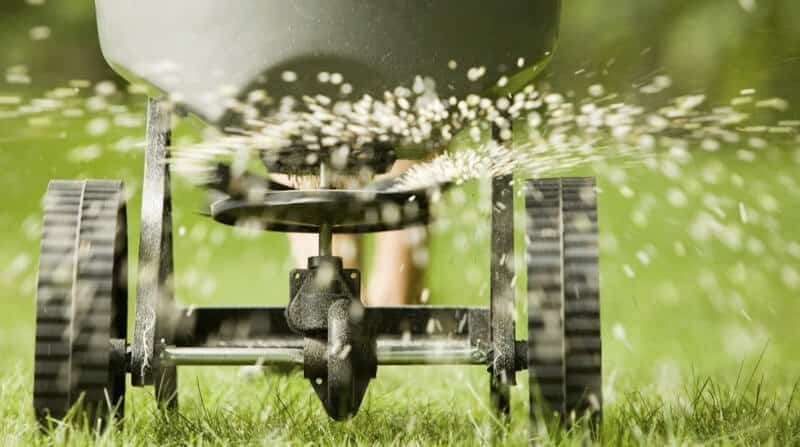
In order for grass to grow and stay healthy it needs three primary chemical compounds;
- Nitrogen
- Potassium
- Phosperous
If your lawn is lacking in these nutrients then grass growth will be weak and your lawn will be threadbare. There will be lots of room for weeds to inhabit as they can thrive in nutrient deficient soil.
Just one good application of slow-release fertiliser a year will keep your grass much healthier, promote growth and give it the strength to fight off infestations.
Read: Lawn Fertiliser: What, Why, When and How to Feed Your Lawn
Also Read: Lawn Feeds Tested: Which Ones to Buy and Why
Now it’s Your Turn
Like many things when it comes to lawn care, removing Dandelions or any of the Dandelion type weeds is a simple process. And preventing them from returning is a matter of a little basic knowledge.
But the fight against Dandelions, as with all weeds, is a never-ending battle. They’re just more persistent than most.
So grab a weedkiller, a spot treatment like Resolva Lawn Spot Weed Killer or a Concentrate like Weedol Concentrated Lawn Weedkiller and get to work.
Or if you prefer, you can try dig them out, making sure to remove the whole root.
Mow your lawn regularly and it’ll become thicker creating less room for seeds to grow.
Then, wait for the autumn and;
- Scarify your lawn to remove excess thatch.
- Aerate it to relieve compaction and,
- Apply a good quality fertiliser.
You’ll be amazed at the difference it makes!
And of course, if you have any questions or suggestions, leave a comment below.
I’d also love to see any before and after pictures. So get in touch and send them in and I’ll share them with our community.
